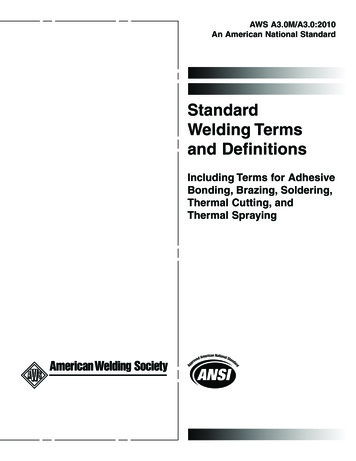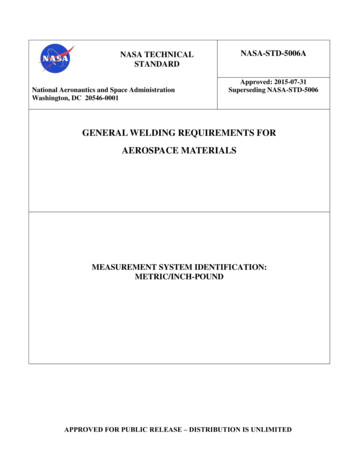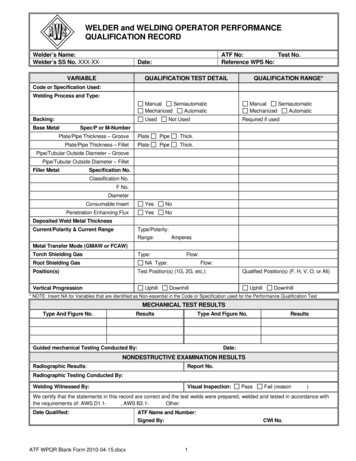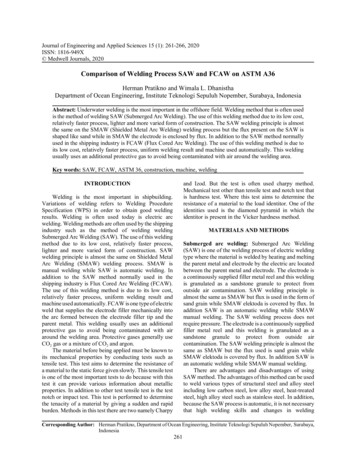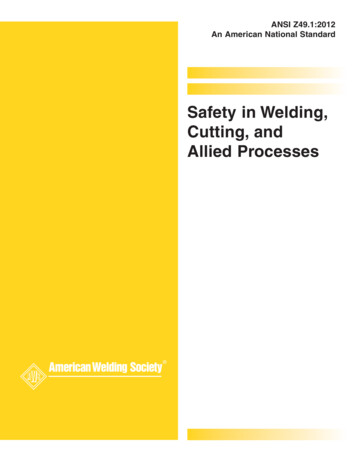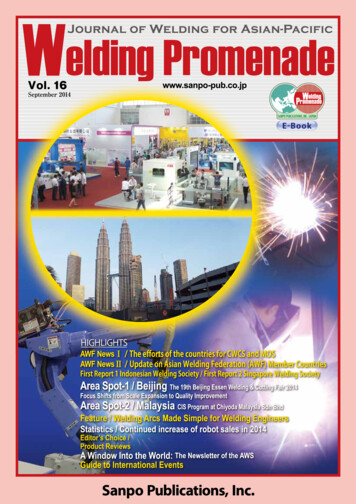
Transcription
AWF NewsAWF News ⅠThe efforts of the countries for CWCS and MOSVol.16 September 2014Contents2 AWF News Ⅰ /The efforts of the countries for CWCS andMOS3 AWF News Ⅱ /Update on Asian Welding Federation (AWF)Member CountriesFirst Report 1 Indonesian Welding Society4 First Report 2 Singapore Welding Society7 Area Spot-1 / BeijingThe 19th Beijing Essen Welding & CuttingFair 2014 Focus Shifts from Scale Expansionto Quality Improvement9 Area Spot-2 / MalaysiaCIS Program at Chiyoda Malaysia Sdn Bhd12 Feature / Welding Arcs Made Simple forWelding Engineers15 Statistics / Continued increase of robotsales in 201416 Editor's ChoiceProduct Reviews17 A Window Into the World:The Newsletter of the AWS18 Guide to International Events /DepartmentsAnnouncing Welding PromenadeNew Digital VersionforSmartphones snd Tables(fee-based)Start receiving in December!PublisherSANPO PUBLICATIONS INCOPORATED1-11 Kanda, Sakuma-cho, Chiyoda-ku,Tokyo 101-0025, JAPANTEL. 81-3-3258-6411FAX. 81-3-3258-6430Sa npo Publ icat ions, I nc. publ ishes notonly Welding Promenade, Welding News,N D T N e w s , We l d i n g Te c h n o l o g y a n dother welding related books in Japan, butalso sponsors and organizes the JapanI nter nat iona l Weld i ng Show 2014 a ndHUBTEC-Welding & Laser Exposition.2Vol. 16 September 2014The 21st Asian Welding Federation (AWF) Governing Council and TaskForce Meeting was held on April 24, at Tokyo Big Sight (as previouslyreported). The Governing Council featured detailed reports from the countriesregarding their implementation plans for the Common Welder CertificationScheme (CWCS) and Manpower Optimization System (MOS), which thecountries have been examining and preparing for since the establishment ofthe AWF. In this paper, we report the efforts of the countries.The Philippine Welding Society (PWS) reported that the Technical Educationand Skills Development Authority (TESDA), a government agency, isimplementing training and evaluation of welders. PWS became able to receivesupport, related to training, from TESDA. Metaphil, a leading company inthe country’s manufacturing industry that utilizes large numbers of welders,became a member of the PWS’s governing council two years ago, and afterobtaining a copy of the authorized certification body (ACB) quality manualfrom the Singapore Welding Society (SWS), it began creating an ACB qualitymanual for the PWS. An application for ACB authorization is expected to bemade in October 2014. Currently, the ACB auditors and examiners have notbeen authorized, but they are planning to take the AWF auditor examinationat the next AWF meeting. The Philippines is now looking into introducingtheir system in three main islands separately, and plans to translate theCWCS documentation from English into local languages.The plan is to implement authorized training center (ATC) auditing in early2015 and to register for TESDA’s MOS in July 2015. The PWS hopes that theCWCS and MOS will finally be operating some time in 2016.The MOS-linked AWF CWCS was adopted because it is a management system,as opposed to the American Society of Mechanical Engineers (ASME) andAmerican Petroleum Institute (API) systems, which are standards. TESDAwishes to build a national welding skills management system with regardto economic integration with the Association of Southeast Asian Nations(ASEAN), which enables skilled workers to move freely within the region.The MOS will not be publishing registration data of welders employedby companies, but it will publish registration data of people who areunemployed or looking for work in the future. It reports that it will also beuseful in employment negotiations.The Mongolian Material Science and Welding Society (MMSWS) already hastwo auditors confirmed and another is going to take the auditor examinationat the current meeting. The society is just starting to prepare for theestablishment of an ACB. It wishes to utilize the implementation plan of thePWS CWCS as a reference.The Indonesian Welding Society (IWS) has started preparing to create aquality assurance (QA) manual for the establishment of an ACB. To beginwith, it will set up model ATCs in Jakarta and Surabaya, but it plans toexpand these, totraining centersaffiliated with thecountry’s Ministryfor Labour. TheHeavy EquipmentManufacturerAssociation of
Indonesia (HINABI) is collaborating in the introductionof the AWF CWCS and MOS systems. IWS also wishes toextend the schemes to the automobile and shipbuildingsectors. However, it reports that the petroleum gasindustries will not be targeted, since they are alreadycommitted to ASME/API welder qualification tests (WQT).The China Welding Association (CWA) reports that thereare approximately 2,050,000 welders in China and thatthe ASME and French standards are used for the WQT, inaccordance with contract requirements. Moves to establishan ACB have begun, with members planned to be includedfrom the petroleum and automobile industries. After theACB is established, ATCs will be set up in Beijing andShanghai. In the future, there will be a need to translatethe CWCS documentation into Chinese.National WQT standards are based on InternationalOrganization for Standardization (ISO) standards and donot vary significantly. China is already implementing WQTsbased on ISO 9606-1 and European (EN) 287-1.AWF News ⅡUpdate on Asian Welding Federation(AWF) Member CountriesFirst Report 1 Indonesian Welding SocietyThe progress of the Indonesian WeldingSocietyIn May 2006, the Indonesian Welding Society (IWS)began examining ways to develop a cooperativerelationship with the Japan Welding Engineering Society(JWES). In October 2006, the two societies signed amemorandum of understanding (MOU) aimed at deepeningtheir exchanges.Furthermore,a f t e r a nexplanatorymeeting fora weldingpersonnelcertificationsystem wash e l d f o rFrom left, Husni Athaillah and Edi Diarmanrelevant partiesfrom Indonesian industry and academia, in 2007 theJWES and IWS concluded a cooperation agreement onthe introduction of a certification system for weldingcoordination personnel. These certification activities wereimplemented within the framework of a Japan-Indonesiaeconomic partnership agreement.At the same time, in 2007, the Indonesian governmentsigned an economic partnership agreement with theJapanese government, known as the Japan-IndonesiaEconomic Partnership Agreement (JI-EPA). Incorporatedinto this agreement was a project “to help improve thelevel of welding technology in Indonesia.” The project wasone of the technical cooperation initiatives and was seenas a means to foster supporting industries in Indonesia andto make the country more competitive internationally. Asa preliminary step towards providing full-scale technicalsupport in the form of overseas development aid (ODA),Japan’s Ministry of Economy, Trade and Industry (METI)set out to implement a basic survey project of the currentstate of fostering welding personnel in Indonesia.Initially, the JWES pursued its own activities for Indonesia,based on its MOU with the IWS, and these ran parallel withthe Japanese government’s activities, which were based onVol. 16 September 20143
AWF Newsthe JI-EPA. However, in response to the IWS’s strong desireto establish a personnel certification system as quickly aspossible, the JWES took over METI’s basic survey projecton contract to the ministry and conducted the project aswelding coordination personnel training. In this way, theJWES efforts to foster welding personnel in Indonesia weremade within the framework of the JI-EPA.Later, in March 2008, the JWES began its certificationactivities in Indonesia by sending over a delegation toimplement its first training course and examination forwelding coordination personnel in the country, as wellas to conduct surveys of existing welding personneltraining courses and examinations, and of educationand training institutes in Indonesia. Since then, in 2008and 2009, the JWES received further contracts from theJapanese government to conduct basic survey projects inIndonesia, and it also continued training and certifyingwelding coordination personnel and seeking to establish acertification system.However, technical cooperation with Indonesia basedon the JI-EPA was defined within a comprehensiveframework as an initiative of the Manufacturing IndustrialDevelopment Center (MIDEC). Within MIDEC, weldingtechnology fell under the category of “interdisciplinarycooperation on fundamental technology and itspromotion.” This MIDEC initiative was to remain in effectfor five years after the signing of the JI-EPA. This meansthe initiative already ended in 2012.However, until then, the JWES certification system forwelding coordination personnel has steadily grown andspread in Indonesia within the five years of activities.This year, over a four-day period from June 6 to 9, atthe request of the IWS, the JWES was present for apart of the 12th WE (welding engineer) training coursefor Grade 1-equivalent welding engineers, as well asfor WE and associate welding engineer (AWE; Grade2-equivalent) examinations. Examinations were held onJune 7 for WE and AWE at the University of Indonesia inDepok, and on June 9 for AWE at the Korin Solo Hotel inSolo. At the University of Indonesia, 10 people took theexamination, and at Solo, 30 people took the examination.The examinations were conducted by the IWS, but theexamination questions were prepared by the JWES.The aim, however, is for the IWS to eventually run theexaminations on its own.Currently, the two societies each have their own rolesin the certification system for welding coordinationpersonnel. For AWE certification, the training, examination,and checking are done by the IWS. For WE certification,the training and examination are done by the IWS, whilechecking is done by both the JWES and the IWS. Forsenior welding engineer (SWE) certification, the training,examination, and checking are done by both the JWES andthe IWS.The IWS has approximately 2,000 individual members4Vol. 16 September 2014and 50 member companies. Principal members are peopleassociated with one of Indonesia’s universities called thebig four—University of Indonesia, Bandung Institute ofTechnology, University of Surabaya, and Gadjah MadaUniversity—and also companies connected to the state, orto foreign-owned or affiliated companies. IWS ExecutiveDirector Edi Diarman points out, “The society also enjoysthe support of Indonesia’s Ministry of Industry. Just twoyears ago we only had 1,400 members, but this yearwe passed the 2,000 mark.” Behind this rapid growthis the economic boom enjoyed by Indonesia’s domesticautomobile industry, as well as the surging demand fornew infrastructure development. Mr. Diarman explains,“Previously the IWS itself was not well known, but asinterest in welding technology has grown, many peoplehave come to learn about IWS. Along with this, we are alsoseeing increasing numbers coming to take examinations toget qualifications as welding coordination personnel.”Mr. Diarman also spelled out some of the aims of theIWS over the coming years: “We would like to sign MOUswith many countries to build cooperative relationshipsand expand our activities. While pursuing a variety ofprojects, we also want to continue holding seminarsand examinations and creating welding-related rules forIndonesia together with government agencies. This willdefine rules for international businesses, and we willpursue an active relationship with the Ministry of Industry,too.”Indonesia has become one of the major countries thatleads the Association of Southeast Asian Nations (ASEAN)nations, and as an emerging market achieving rapideconomic development, it is now attracting the attention ofthe world for its remarkable potential. The role of the IWSis to ensure the progress and advancement of the weldingtechnology that serves as a fundamental technology ofmanufacturing in Indonesia. There is hope for furtheradvancement in the future.AWF News ⅡFirst Report 2 Singapore Welding SocietyThe State of Nondestructive Inspection inSingapore and Business Development ofthe Singapore Welding SocietyWhen accepting orders for U.S.-related welding workfor construction or manufacture, it is essentialthat the quality of welding is checked by an AmericanWelding Society-Certified Welding Inspector (AWS-CWI).In addition, with an ever growing appreciation of theimportance of product liability (PL) and quality assurance(QA) for welded structures, construction with the need forthis kind of qualification is predicted to increase, even forwelding projects unrelated to the U.S.
Meanwhile, in India, China, andSoutheast Asia, the manufactureof parts and structures involvingwelding continues to expand rapidly.At the same time, the demands ofquality control for welded structuresis becoming more stringent by theSze Thiam Siongyear, and in many cases the AWSCWI qualification system is being adopted as a means ofapplying a common Asia-wide quality control scheme.Qualified AWS-CWIs are given the authority to verifywelding procedures, certify techniques of welders, etc., andQualified AWS-CWIs have proved indispensable for qualitycontrol based on actual operations.In this article, we recount a visit to Setsco Services PteLtd. (Setsco) in Singapore, an early adopter of AWS-CWIcertification in Asia, and the discussion about the company’soperation of AWS-CWI with General Manager Sze ThiamSiong (Singapore Welding Society, SWS, president) (Photo1). We also asked about some of the SWS’s future businessdevelopments.The taxi ride from Singapore’s Changi Airport wasapproximately 20 minutes. Heading from Jurong TownHall Road to Teban Gardens Crescent, we reached thepremises of Setsco at the corner of an industrial estate. Anew office building faces the road (Photo 2), while furtherwithin is the company’s training center (Photo 3).Setsco has a broad range of experience spanning 30years, and it is now one of Singapore’s largest testing andinspection companies, with accreditation under a host ofschemes, including ISO/IEC 17025 and ISO/IEC 17020,as well as the Singapore Laboratory Accreditation Scheme(SINGLAS) for ISO/IEC Guide 65, certified by the SingaporeAccreditation Council (SAC).Setsco offers comprehensive testing, measurement,inspection, certification, consulting, and training servicesto major markets including aerospace, petrochemistry,petroleum refining, offshore structures, food andbeverages, electronics, environment, medical technology,pharmaceuticals and biotechnology, construction, andequipment.The company’s main business activities include thefollowing: Environmental measurement and consulting Chemical analysis Food hygiene consulting and training Clinical laboratory services Structural integrity testing Inspection of structural steel frame materials andproducts Mechanical inspection Metallurgical analysis Maintenance testing Calibration and measurement Electrical and electronic testing Nondestructive testing (NDT) NDT and welding consulting Aerospace inspection Advanced NDT Third-party inspection and engineering inspection Product and personnel certification Technical trainingIn the company’s 4th floor conference room hang a largenumber of authentication certificates.The AWS-CWI certification program was introducedto Singapore by the SWS in 1985. Since then, thiscertification program has been organized periodically,gradually becoming accepted by the country’s industry.While Singapore was the first country in Asia to adoptthis program, many other countries have since introducedit too, including India, China, Japan, Korea, Malaysia,and Taiwan. Setsco reports, “This certification programhas achieved widespread recognition within the weldingindustry, both within Singapore and internationally, andthe requirement for personnel who are qualified under thiscertification scheme tends to be designated in employmentcontracts and project specifications.”Last year, Setsco trained more than 3,000 weldinginspectors, and thereby 1,000 or more welding inspectorsearned AWS-CWI certification. As a company rule, all ofthe company’s welding inspectors must obtain AWS-CWIcertifications as one of their occupational qualifications.The reason for such a rule is that “as a service provider,Setsco must guarantee that its own welding inspectorshave the experience and qualifications necessary toperform the work assigned to the company.” Accordingto Setsco, this certification program gives the company’sclients the confidence that they can depend on the certifiedwelding inspectors to effectively handle their work.In addition to Singaporeans, many of the people whoattend AWS-CWI training or take AWS-CWI examinationsin Singapore come from Malaysia and various otherneighboring countries. The Singaporean governmentactually cooperates quite closely with the SWS, and due inpart to its policy of promoting improved public education,it even provides support with training expenses forwelding.As expressed in the phrase “Asia’s domestic demand”, acommon Asia-wide market is currently taking shape. TheAWS-CWI scheme helps in this by offering a commonyardstick for weld quality—something that is essential tothe manufacturing industry—and by making it easier toassess the quality and durability of welded structures andproducts.Since Mr. Sze Thiam Siong is also the president of the SWS,he spoke to us about the future business developmentsof the SWS. He pointed out, “The SWS is one of the feworganizations having a long history in Singapore. Ithas been operating steadily now for 36 years, since itsestablishment in 1978. It started out with only a handfulVol. 16 September 20145
of welding specialists, but the SWS has grown now, froma small local organization to an organization engaged invarious international initiatives.”Mr. Sze also said, “The SWS was one of the foundingmembers of the Asian Welding Federation (AWF), whichevolved later from the Association of Southeast AsianNations (ASEAN) Welding Federation, and it is also amember of the International Institute of Welding (IIW).However, the SWS is currently faced with a challenge. Aswell as pursuing its welding-related projects, it is tryingto attract more young people to welding as a career. Thischallenge has become more difficult as Singapore hasdeveloped and its society has become richer. The numberof people choosing to work as welders is decreasing, andas a small organization in a small country with a smallpopulation, the SWS’s task of attracting more peopleto welding is more difficult than in most other ASEANnations.”Mr. Sze stated, “My personal view is that the SWS willhave to keep monitoring the global trends of the weldingindustry and continually review its role to ensure that itremains relevant and effective in the future. Some of thetasks in progress that the SWS is focused on are Promoting productivity and innovation in the weldingindustryThe SWS can promote greater automation by upgradingthe technological capabilities of the welding industry andalso by giving priority to support that helps to maintaina high level of competitiveness. This means encouragingmanufacturing companies, through forging partnershipswith the SMS, to efficiently adopt more welding processesin their various production processes, as well as sharingexperience and knowledge in the application of automated6Vol. 16 September 2014welding systems. Changing the image of welding as a profession in theindustrial worldThe SWS also aims to counter the old but widespreadperception that welders are merely blue collar workerswithin society and to help transform the image of weldingtechniques and welding specialists as individuals whopossess the highly developed knowledge and expertise toperform high-quality joining. This effort can help to elevatethe status and reputation of welders and vitalize weldingas an occupation within the industrial world. Recruiting young people needed for the SWS to becomeits membersThe SWS is reviewing its recruiting and membershipprocesses and working to make itself more appealing tothe young people who can help to energize its businessactivities by becoming members. To this end, the SWS isboth enhancing its existing methods and embracing newapproaches. Promoting greater member participation and increasingmembershipThe SWS can provide a platform for members to facilitatethe sharing of knowledge and experience through bettercommunication and networking. In this way, it can alsohelp members to increase their individual expertise andoffer them opportunities to obtain qualifications.To conclude, we think that regardless of membership,these efforts help the SWS to develop a greater sense ofpurpose and to ensure that it becomes a more effectiveand relevant organization.”
1BeijingThe 19th Beijing Essen Welding & Cutting Fair 2014Focus Shifts from Scale Expansion to Quality ImprovementScene of exhibition venue, which was 20% smaller, in terms of scale of exhibition, than the previous fair.The 19th Beijing Essen Welding & Cutting Fair2014 was held over four days, from June 10 to 13,at the China International Exhibition Center in Beijing.This year was the 19th time the event has been heldpared to the previous fair in Beijing in 2012, exhibitingcompanies were down about 15% and exhibition spacewas down about 20%.since the inaugural fair in 1987. Thus far, the BeijingEssen Fair has grown almost continuously, in the context of the rapid growth of China’s economy. The pe-riod of high growth of the Beijing Essen Fair seems tohave come to an end, however. At the recent fair, therewere 800 exhibiting companies and an exhibition spaceof 38,000 m 2. Compared to the previous fair held inShanghai in 2013 where there were 1,019 exhibitingcompanies and an exhibition space of 48,303 m 2, thisrepresents a decline of 219 companies (21.5%) exhibiting and 10,000m2(20.9%) in exhibition space. Com-Lineup of the world’s leading robot manufacturers as though it werea robot avenue, including FANUC Corporation, Comau SpA, YaskawaElectric Corporation, ABB, Kuka Roboter GmbH, and Kemppi.Vol. 16 September 20147
Furthermore, although there was ahuge rush of visitors on the secondday, the fair started fairly slowly onthe first day, when the number ofvisitors is highest in usual years. Onthe third and fourth days, the num-ber of visitors was quite subdued.Attendance was far from the usuallarge crowds of the Beijing EssenceFair.In terms of content, on the otherhand, the event was very interesting. The character of the fair wasshifting from scale expansion toShenZhen Huayilong Industrial Co., Ltd., which expanded into the field of laser technology,exhibits a 1 kW fiber laser cutting machine.quality improvement. The current shortage of skilled la-In addition, the world’s leading robot manufacturersand efforts to ensure stable and high levels of qualityber of laser processing-related exhibits.bor is clearly driving a strong demand for robot systems,are evident.8were present, and there was a striking rise in the num-Jasic is expanding into arc welding robots in partnership withKawasaki Heavy Industries, Ltd.Panasonic Corporation was quick to bring in the directsemiconductor laser processing robot that it exhibited at theInternational Welding Show held in Tokyo in April.Daihen exhibits a cordless teaching system, the first time thistechnology has appeared in ChinaKaierda actively promotes its joint venture with Yaskawa ElectricCorporation.Vol. 16 September 2014
2MalaysiaCIS Program at Chiyoda Malaysia Sdn BhdProject to Create Research and Educational Hubs for Innovative Manufacturing in AsiaDiscussion with staffOsaka University is home to the Joining and Welding Research Institute (JWRI), which is the only Joint Usage /Research Center in Japan related to welding science, as wellas to the Graduate School of Language and Culture, Schoolof Foreign Studies, which is the only institute in the countrywith the educational and research resources to cover 27 ofthe world’s languages. Through an organic fusion and thecollaboration of humanities and sciences, these two havelinked up to launch the “Project to Create Research andEducational Hubs for Innovative Manufacturing in Asia”, aSpecial Budget Project of the Ministry of Education, Culture, Sports, Science and Technology scheduled to run forfive years starting in 2013 and aimed at developing solutionsto a variety of problems arising from the accelerating paceof globalization.One of the specific activities of the plan is “an initiativeto cultivate globalized students who develop a specialization, understand multiple languages and cultures, and areequipped with high-level communication and self-development skills (professional training project), through aninteractive training program at Japanese-owned or affiliatedmanufacturing businesses in the greater Asian region.” Thisis a key issue of the whole initiative. This training projectaims at fostering students with diverse outlooks and knowledge of different cultures and languages, by implementingJapan’s first hands-on manufacturing training for globalprofessionals, which is based on the new concept of coupling internship (CIS), where a pair of students (one fromhumanities and the other from sciences, or one from Japanand the other from the greater Asian region) study and worktogether at a Japanese-affiliated company.The goal of the CIS Program is to foster professionals capable of demonstrating true leadership on a world stage. It is aglobal professional training system that aims at improvingproblem-solving and communication skills through a handson training course, implemented as an internship at a globalcompany. The program is the fruit of the combined effortsof Osaka University sciences (Graduate School of Engineering) and humanities (School of Foreign Studies) schools andlocal universities in the greater Asian region (sciences andhumanities). This overseas internship scheme is differentfrom conventional overseas programs, which place emphasison language learning. The idea is that students of differentacademic disciplines, in a setting where they face a differentlanguage and culture, undergo training together at a globalcompany in order to develop the problem-solving and communication skills necessary to work as leaders in globalmanufacturing. At the same time, they not only becomefamiliar with an actual manufacturing plant, they also get toexperience an international standard production facility, andthereby broaden their minds.In the first year of the project, 2013, internships were held inIndonesia (PT. Komatsu Indonesia/University of Indonesia),Vietnam (Fujikin Vietnam Co., Ltd./Hanoi University ofScience), and Thailand (Thai-Kobe Welding Co., Ltd./Kasetsart University).In this article we report on the CIS Program held from August 21 to 29, 2014 at Chiyoda Malaysia Sdn Bhd (ChiyodaMalaysia) in Kuala Lumpur, Malaysia.A total of eight students from two universities, Osaka University and the University of Malaya, participated in thisCIS Program. Two engineering students and two foreignlanguages students were selected from each university. Theprogram leaders were Tetsuo Suga, a visiting professor atOsaka University’s JWRI, along with Nobuko Yoneda andKuniko Fujiwara. Dean Yoneda is a professor at the OsakaVol. 16 September 20149
2MalaysiaUniversity Graduate School of Language and Culture (andvice dean of the School of Foreign Studies), while Professor Fujiwara is a Project Assistant at the same school. Onthe day before visiting Chiyoda Malaysia, the students wentto the University of Malaya to attend a lecture by ProfessorSuga on the fundamentals of welding, and to participate in atraining session with Dean Yoneda and Assistant ProfessorFujiwara on cross-cultural communication and interviewtechniques.The company hosting the internship, Chiyoda Malaysia, isone of the global engineering companies of Chiyoda Corporation of Japan, which was established on June 12, 1974to work in the petroleum and petrochemical industries. Thecompany has made a substantial contribution to the growthand prosperity of Malaysia’s petroleum and gas industries.Chiyoda Malaysia also provides high-level services formulti-disciplinary engineering, procurement, construction,and commissioning for turnkey projects, as well as feasibility studies, front-end engineering design, detailed engineering, project management, and construction management inoil and gas, petrochemical, chemical, and related industries.Committed to quality, the company is certified under ISO9001:2008 in the area of “Provision of Engineering, Procurement, Construction and Commissioning Services forOil & Gas, Petrochemical and Other Related Industries”.Chiyoda Malaysia’s main business activities are projectfeasibility studies; basic engineering/front-end engineeringdesign (FEED); detailed engineering design; engineering,procurement and construction (EPC); engineering, procurement, construction and commissioning (EPCC); engineering, procurement and construction management (EPCM);and project cost estimation for projects such as petroleumrefineries/plants, chemical plants, bulk storage terminals,LPG terminals, and industrial facilities, along with plantmodifications and revamping.On August 21, the first day of the internship, the studentswere met on their arrival at Chiyoda Malaysia by Yukihiro Shibahara, the company’s Commercial Manager, whopromptly led them to a meeting room at the training site.To begin, Mr. Shibahara welcomed the group warmly. Inresponse, Assistant Professor Fujiwara offered a greeting forInspecting an actual workplace on an office tour10Vol. 16 September 2014the start of the internship, saying, “We are honored to holdthis program here at Chiyoda Malaysia. We would like tothank all the staff of your company for taking the trouble tohost the CIS Program.” She also explained the significancecreating a global network through an industry-academiapartnership with the company. Next, Chiyoda MalaysiaManaging Director Shaiful Bin Othman ga
Welding Society-Certified Welding Inspector (AWS-CWI). In addition, with an ever growing appreciation of the importance of product liability (PL) and quality assurance (QA) for welded structures, construction with the need for this kind of qualification is predicted to increase, even for welding proj



